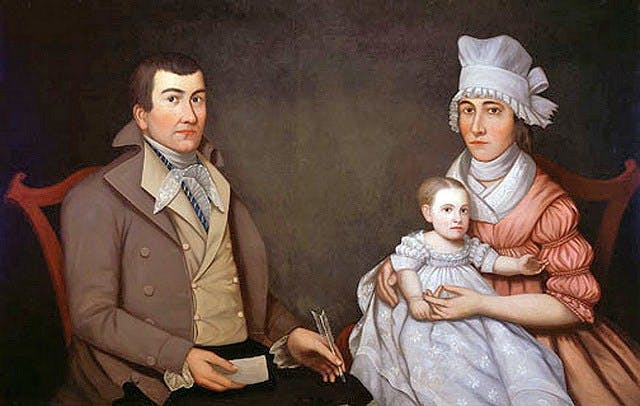Early American Names Beyond George & Martha: What names were popular then and why?
By Brian Tomlin
Looking at names that were popular in the early days of the U.S. gives us a chance to reflect on how much we have changed and evolved over the last two centuries. We are clearly more multicultural as a society in terms of how many different countries, languages, ethnicities and cultural traditions we draw from in choosing names for our children.
Most of the common names in the early nineteenth century in this country came from the British tradition, and in fact, the lists of popular names would be almost identical for England and America. And yet names were chosen from some of the same sources as today: family histories, celebrities, religious traditions and popular entertainment. The lack of variety or originality of the name lists from this period belies the fact that names were chosen to denote respectability rather than the individuality valued today.
Presidential Names:
Two of the most popular names of the period were George and Martha, the first names of the nation’s first President and First Lady. George Washington was popular for having been a leading general in the Revolution. I know that in my own genealogy I have several ancestors who were given the first and middle name George Washington. Presidents and their families were some of the biggest celebrities of the era, receiving nationwide newspaper coverage in an era when most forms of entertainment were largely local.
Not only were the first names of the Presidents and their families inspiring to Americans, as the nineteenth century wore on many of the Presidential surnames (Jefferson, Jackson, and Harrison for example) became common given or middle names. What did the early Presidents (serving from 1789-1837) name their own children? These lists are a good sampling of the most common American names of the early years of the nation:
George and Martha Washington: George Washington married a widow who had children from a previous marriage
Daniel (born 1751), Frances (1753), John (1754) and Martha (1756)
John and Abigail Adams:
Abigail “Nabby” (1744), John Quincy (1767), Susanna (1768), Charles (1770), Thomas (1772), Elizabeth (1777)
Thomas and Martha Jefferson:
Martha “Patsy” (1772), Jane (1774), Mary “Polly” (1778), Lucy (1780), Lucy Elizabeth (1782, because the first Lucy died in infancy, and infant mortality was so common that names were often reused in such cases)
James and Dolley Madison:
John (1792)
James and Elizabeth Monroe:
Eliza (1786), James (1799),Maria (1803)
John Quincy and Louisa Adams:
George Washington (1801), John (1803), Charles (1807), Louisa (1811)
Andrew and Rachel Jackson: Jackson adopted three children and served as guardian for eight more. (Birth dates not available for Jackson’s children)
Andrew, Lyncoya (a Creek Indian, one of two Native Americans adopted by Jackson), John Samuel, Daniel, Carolina, Eliza, Edward, and Anthony
Biblical names:
Names chosen from the Bible have always been popular, but the types of names selected have gone through periods of fashion. Early settlers and colonists often identified themselves with figures from the Old Testament, feeling they were facing similar trials from a demanding God. By the early nineteenth century, however, you see many more boys being named after New Testament figures such as John, Peter, Thomas, and Paul. Girls were called names like Mary or Martha. Both boys and girls might be given more obscure names from either the Old or New Testament as middle names.
Literary names:
Novels published during the early years of the nation (both in the U.S. and imported from London) were perhaps another source of inspiration. In the late eighteenth and early nineteenth century, the two main literary styles were romanticism and gothic novels.
The first novel published in America was William Hill Brown’s The Power of Sympathy (1789), with characters such as Harriott, Myra, and Eliza.
Charlotte Temple (1794) by Susanna Rowson was the most popular novel in America from its publication until Uncle Tom’s Cabin was published in 1852.
In the early decades of the nineteenth century Jane Austen’s novels were very popular with its standard list of names:
Female: Anne, Caroline, Catherine, Charlotte, Elinor/Eleanor, Elizabeth, Fanny, Harriett, Isabella, Jane, Lydia, Maria, Marianne, Mary
Male: Charles, Edward, Frederick, George, Henry, John, Robert, Thomas, William
Family Tradition:
Through studying many genealogies, it is clear that the practice of reusing and repurposing names from older family members was practiced very regularly in early America. Parents would also name children after themselves (mother and father), their parents, grandparents or siblings.
Brian Tomlin is a writer and editor based in Philadelphia who is interested in the history, literature and popular culture of the eighteenth and nineteenth centuries. His personal blog Brian Beholds can be found at www.briantomlin.com .


